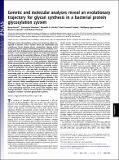Genetic and molecular analyses reveal an evolutionary trajectory for glycan synthesis in a bacterial protein glycosylation system
Author(s)
Børud, Bente; Viburiene, Raimonda; Paulsen, Berit Smestad; Egge-Jacobsen, Wolfgang; Koomey, Michael; Hartley, Meredith D.; Imperiali, Barbara; ... Show more Show less
DownloadBorud-2011-June-Genetic and molecula.pdf (928.8Kb)
PUBLISHER_POLICY
Publisher Policy
Article is made available in accordance with the publisher's policy and may be subject to US copyright law. Please refer to the publisher's site for terms of use.
Terms of use
Metadata
Show full item recordAbstract
Although protein glycosylation systems are becoming widely recognized in bacteria, little is known about the mechanisms and evolutionary forces shaping glycan composition. Species within the genus Neisseria display remarkable glycoform variability associated with their O-linked protein glycosylation (pgl) systems and provide a well developed model system to study these phenomena. By examining the potential influence of two ORFs linked to the core pgl gene locus, we discovered that one of these, previously designated as pglH, encodes a glucosyltransferase that generates unique disaccharide products by using polyprenyl diphosphate-linked monosaccharide substrates. By defining the function of PglH in the glycosylation pathway, we identified a metabolic conflict related to competition for a shared substrate between the opposing glycosyltransferases PglA and PglH. Accordingly, we propose that the presence of a stereotypic, conserved deletion mutation inactivating pglH in strains of Neisseria gonorrhoeae, Neisseria meningitidis, and related commensals, reflects a resolution of this conflict with the consequence of reduced glycan diversity. This model of genetic détente is supported by the characterization of pglH "missense" alleles encoding proteins devoid of activity or reduced in activity such that they cannot exert their effect in the presence of PglA. Thus, glucose-containing glycans appear to be a trait undergoing regression at the genus level. Together, these findings document a role for intrinsic genetic interactions in shaping glycan evolution in protein glycosylation systems.
Description
This article contains supporting information online at www.pnas.org/lookup/suppl/doi:10.
1073/pnas.1103321108/-/DCSupplemental.
Date issued
2011-05Department
Massachusetts Institute of Technology. Department of Biology; Massachusetts Institute of Technology. Department of ChemistryJournal
Proceedings of the National Academy of Sciences
Publisher
Proceedings of the National Academy of Sciences (PNAS)
Citation
Borud, B. et al. “Genetic and Molecular Analyses Reveal an Evolutionary Trajectory for Glycan Synthesis in a Bacterial Protein Glycosylation System.” Proceedings of the National Academy of Sciences 108.23 (2011): 9643-9648. Web. 8 Feb. 2012.
Version: Final published version
ISSN
0027-8424
1091-6490